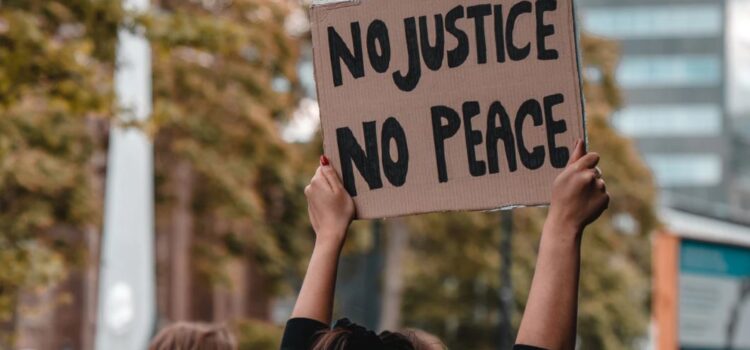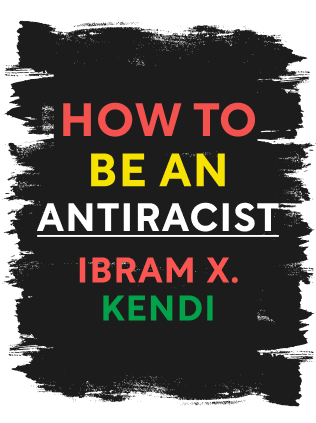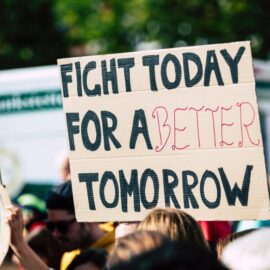

This article is an excerpt from the Shortform book guide to "How to Be an Antiracist" by tIbram X. Kendi. Shortform has the world's best summaries and analyses of books you should be reading.
Like this article? Sign up for a free trial here .
What are the different types of racism? How did Ibram X. Kendi experience each of the types of racism?
According to Kendi, racism comes in many forms. In How to Be an Antiracist, he describes the different types of racism and shares his personal experiences with them.
Keep reading for Kendi’s experiences with six different types of racism.
Types of Racism
How to Be an Antiracist discusses ethnic racism, bodily racism, cultural racism, gender racism, queer racism, and behavioral racism, among other critical topics. In his discussion of each, Kendi shares his experiences. Through the eyes of Kendi, racism is seen everywhere even where you might have previously overlooked it.
Ibram’s Experiences With Ethnic Racism
Ibram has had plenty of experience with types of racism related to ethnicity over the years. When he was younger, he held ethnically racist ideas that he later realized were a problem.
Eighth Grade Class
In Ibram’s eighth grade class, everyone was made fun of for something. Because of his large head, Ibram was nicknamed Bonk, after a cartoon character with a ridiculously large head who headbutted his enemies.
Another student, Kwame, was Ghanaian, and the class made fun of him for being an immigrant. They likened him to Akeem, a prince from a fictional African country who comes to Queens to find a wife in the movie Coming to America. Throughout the movie, characters make fun of Akeem by suggesting that Africa is uncivilized and things like wearing clothes must be a new experience for him.
In the Neighborhood
Ibram also experienced tensions between ethnic groups in his neighborhood. Ibram’s neighbors were a Haitian immigrant couple with sons Ibram became friends with. While the parents were polite, they kept Ibram at a distance. He thought it might have had something to do with the fact that at the time, African Americans were exhibiting bigotry towards Haitian immigrants.
Where Are You From?
People often assume Ibram is an immigrant because ethnic racists assume that as a successful writer and professor, he can’t be African American. When he answers that he’s from Queens, his father is from New York, his mother is from Georgia, and that he’s a descendant of enslaved Africans, the questioners give up. They either think he’s an exception, or they lecture him about how lazy his ethnic group generally is.
Ibram’s Experiences With Bodily Racism
Ibram had internalized, complicated, contradictory feelings about bodily racism growing up. In ninth grade, he went to a high school in central Queens that had a large population of Black, Asian, and Latinx students, and Ibram was scared of the other Black kids. There were some legitimately scary Black kids at his school, such as Smurf, who beat up kids on the bus and once pulled a gun on Ibram. Ibram defused the situation by telling Smurf he wasn’t scared and complimenting the weapon. Smurf bullied other people too, and Ibram was never brave enough to step in, which he regrets to this day.
However, a good portion of the time, Ibram’s fears of other Black people were unfounded. If he accidentally bumped into someone in the hall or walked through a group of crew members, nothing happened. The disinterested teachers, overcrowding, and large class sizes were probably more dangerous than the students.
Ibram’s parents also worried about other Black people. They didn’t like it when Ibram played basketball at neighborhood courts—they worried he’d get shot—and Ibram’s father eventually built a court in the backyard.
At the same time, Ibram thought his neighborhood was safe enough. He knew it had certain dangers but he didn’t think it was a hellhole of violence, and he never connected the violence to Blackness.
Ibram’s Experiences With Types of Racism Focused on Culture
Ibram loved African American culture, which he first experienced in church. Strangers called each other brother and sister, the congregation called back at preachers, choir members swayed to the music, and funerals were full of life. According to Kendi, racism like this is cultural racism.
The Ave
Ibram also experienced culture whenever he visited the Ave, the intersection of Jamaican Avenue and 164th Street. Ibram’s generation didn’t care if adults or White people didn’t like their clothes or language. They wore baggy jeans, bubble coats, Nike Air Force 1s, or dangling chains. It wasn’t just about what you wore, either, it was how you wore it—experimentation was part of the culture. Shoes were especially important. Ibram and his friends would take measures to make sure the fronts of the shoes didn’t crease, such as stuffing them at night or wearing them with a sock rolled up over their toes to pad out the front. It wasn’t comfortable, but it was fresh.
The Ave was also full of hip-hop. Cars and stores would play music, people walking by practiced out loud, and people rapped on corners. Ibram considered hip-hop to be oral poetry, short stories, and adventure fantasy.
Southern Culture
In 1997, Ibram and his family moved to a predominantly White neighborhood in Manassas, Virginia. The first night Ibram was there, he was worried the KKK would show up because he’d heard plenty about Black people being abused in the South.
When Ibram was fifteen, he believed in multiculturalism. He knew his own culture was legitimate. However, that didn’t stop him from looking down on the cultures of Southerners. He thought their music was terrible, they couldn’t dress, and their basketball players were “scrubs.” He was arrogant, and this kept potential friends at a distance. Furthermore, he thinks his cultural elitism probably cost him a spot on the junior-varsity basketball team.
Ibram didn’t have the whole picture. He knew that generally looking down on a culture was wrong—he would never say Black people were culturally inferior. He would, however, judge specific Black cultures, and it took him two years to begin to respect the culture of North Virginia and make friends.
Ibram’s Experiences With Gender Racism
Ibram’s initial ideas on gender were shaped by his parents. They didn’t raise him to be sexist, but they didn’t train him to be a feminist either. Ibram’s parents didn’t always adhere to traditional gender roles—for example, when Ibram’s parents got married, the pastor recited the traditional wedding vows that included husbands loving their wives and wives obeying their husbands. But Ibram’s mother refused to agree to obey him, which shocked both the pastor and his father. His father asked if she would be all right with changing the vow to “submit one to another.”
However, sometimes his parents demonstrated sexist ideas. His mother called his father the head of the family, and he would lead while she submitted.
Meeting Kaila and Yaba
Ibram started to reevaluate his ideas about gender at Temple University when he met Kaila, a strong lesbian woman who was ahead of him in the doctoral program. Together with Yaba, another strong woman, Kaila led the program’s discourse. Whenever a homophobic, patriarchal, or racist idea came up, the two women went after it.
Ibram was terrified of them and tried to avoid them because he was worried he’d bring up an offensive idea and be called on it, but he also admired their confidence and intelligence. He read the books they brought up and tried to learn more about gender racism because he wanted to change his ideas.
Kaila and Yaba broke all the stereotypes of homophobia and the patriarchy—they weren’t sex-crazed, they weren’t abnormal, and they didn’t hate men or want female supremacy. They showed Ibram that it was power and policies, not specific groups of people, that were the problem.
Ibram’s Experiences With Queer Racism
Like Ibram’s ideas on gender, his ideas on sexuality were shaped by his upbringing. His parents didn’t raise him to be homophobic or sexist, but they rarely talked about queer people.
Weckea
Ibram had two close friends at Temple University, Weckea and Raena. One day, Raena told Ibram that Weckea was gay. Ibram wasn’t comfortable with homosexuality and thought Raena might be trying to break up his friendship with Weckea.
Up until this point, Ibram held some stereotypical beliefs about Black gay men, such as that they were reckless, sex-crazed, and performed feminity. (Performing femininity or masculinity refers to authentically expressing gender, as opposed to acting.) Weckea didn’t fit into Ibram’s stereotypes at all—he was private and performed masculinity.
Ibram was faced with a choice—maintain his homophobia or maintain his friendship with Weckea. Ibram chose Weckea and began dismantling his homophobia. He let his stereotypical beliefs go and learned from Weckea how to recognize homophobia in others.
Also, as Ibram had done with race as a child, he acknowledged his gender and sexuality. He identified as a cisgendered (his gender identity is the same as his birth sex) heterosexual Black male, and being cis, male, and hetero came with privilege he could use to support people of other sexualities.
Ibram’s Experiences With Types of Racism About Behavior
Academic Achievement
Ibram’s grades were low throughout much of high school, and because it was the nineties and he was a Black teenager, people put a lot of pressure on him. They told him that his bad behavior reflected badly on the entire Black race. His grandparents’ and parents’ generations were fond of using Martin Luther King Jr. to shame individuals by saying that they were throwing away everything he’d fought for.
Part of the reason Ibram was checked out in the first place was racism—he’d gone to overcrowded schools (often the result of racist school-zoning policies) and regularly experienced racist abuse. However, he, like every Black person, was expected to overcome all this, and if he couldn’t, it was his fault.
Speech Contest
When Ibram was in his senior year of high school, a classmate, Angela, told him about the Martin Luther King speech contest. She convinced him to participate and he wrote a speech about “Black behavior.” Reflecting on the speech today, Ibram thinks King would have hated it. It was a version of the shaming speeches directed at him from the civil-rights generation—it was about all the things that were wrong with Black youth, such as their lack of interest in education, lack of ambition for anything besides music or sports, and unwillingness to do anything about people’s perception of them as frightening.
It may have been racist, but when Ibram showed Angela his speech, she loved it. So did the judges—Ibram won his high school competition and went on to compete at the county level. Winning made him feel better about himself and his academics. Ironically, he only escaped the behavioral racism of others by engaging in behavioral racism himself, against other Black people.
College
Ibram got into two colleges and decided to attend Florida A&M University (FAMU). He told people he chose it because it “felt right,” which is often what people say when they don’t want to look into their motives too closely. Reflecting on the decision, Ibram realized he didn’t only want to be around other Black academic superstars; he wanted to get away from those he viewed as badly behaving Black people.

———End of Preview———
Like what you just read? Read the rest of the world's best book summary and analysis of Ibram X. Kendi's "How to Be an Antiracist" at Shortform .
Here's what you'll find in our full How to Be an Antiracist summary :
- What racism is and how it evolved
- How you might have subtle racist thoughts and not even be aware of them
- Why being "not racist" isn't good enough






